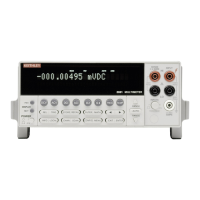Front Panel Operation
3-50
THERMOCOUPLE TYPE:
This option of the THERMO-
COUPLE SETUP menu brings up a menu of thermocouple
types:
THERMOCOUPLE TYPE
JKTERSBN
To select a type, highlight it and press ENTER.
REF-JUNCTIONS:
This item of the THERMOCOUPLE
SETUP menu allows you to select one of five reference junc-
tions for further configuration. Typically, each thermocouple
card uses a single reference junction. The menu is displayed
as follows:
CONFIGURE REFJCNS
JCN1 JCN2 JCN3 JCN4 JCN5
After choosing one of the reference junctions, you can con-
figure it further or acquire a reference temperature (to update
the stored reference temperature), as shown in the typical
following menu:
REFERENCE JUNCTION#1
CONFIGURE ACQUIRE-REF-TEMP
Choosing the ACQUIRE-REF-TEMP option updates the
stored reference temperature used for generating a tempera-
ture measurement. If the junction type (JCN) is simulated,
the defined simulated junction temperature is used. If the
junction type is real, you must manually close that channel
from the scanner before acquiring the temperature.
Selecting the CONFIGURE option displays a configuration
menu for a particular reference junction (#1 through #5):
CONFIGURE REFJCN#1
SIMULATED-TEMP REAL-JUNCTION
The SIMULATED-TEMP option allows you to enter a de-
fault temperature. Typical reference junction temperatures
are 0°C and 23°C. (Note the reference junction temperature
is shown in the units selected by the SET TEMP UNITS
menu.) The REAL-JUNCTION option lets you enter values
for a temperature coefficient for the selected reference junc-
tion (in mV/°C) and an offset voltage (in mV at 0°C). Con-
sult the Model 7057A or 7402 manual for correct
configuration.
UNITS
This parameter selects the displayed units for temperature
measurements. You can program the temperature units pa-
rameter as follows:
1. From the CONFIG TEMPERATURE menu, select
UNITS and press ENTER. The following menu is dis-
played:
SET TEMP UNITS
DEG-C DEG-F K
2. Highlight the desired units and press ENTER.
There is a multiple display for the temperature function that
shows the reading expressed in all three temperature units.
SPEED
The SPEED parameter sets the integration time of the A/D
converter, the period of time the input signal is measured (al-
so known as aperture). It is discussed in paragraph 3.4.1, DC
and AC voltage. Only the differences for temperature are
noted here.
The SET-BY-RSLN parameter optimizes the integration
time for the present resolution setting. The defaults for set-
by-resolution integration times of temperature are listed in
Table 3-25.
FILTER
The FILTER parameter lets you set the digital filter response
and control its on/off operation. It is described in paragraph
3.9. Only the specifics for temperature are covered here.
The advanced filter is not available for the temperature func-
tion.
The AUTO parameter for a digital filter optimizes its use for
the present measurement function. The defaults for automat-
ic filtering of temperature are as follows:
Averaging
State Type Readings Mode
On Averaging 10 Moving
Table 3-25
Temperature integration time set-by-resolution
Resolution
degrees
Resolution
digits
Integration
time
1 degree
0.1 degree
0.01 degree
0.001 degree
3.5d
4.5d
5.5d
6.5d
1.0 PLC
1.0 PLC
1.0 PLC
1.0 PLC
Note: If the integration time is SET-BY-RSLN and the resolution
AUTO, the integration time will be 1.0 PLC and the resolution set
by sensor.

